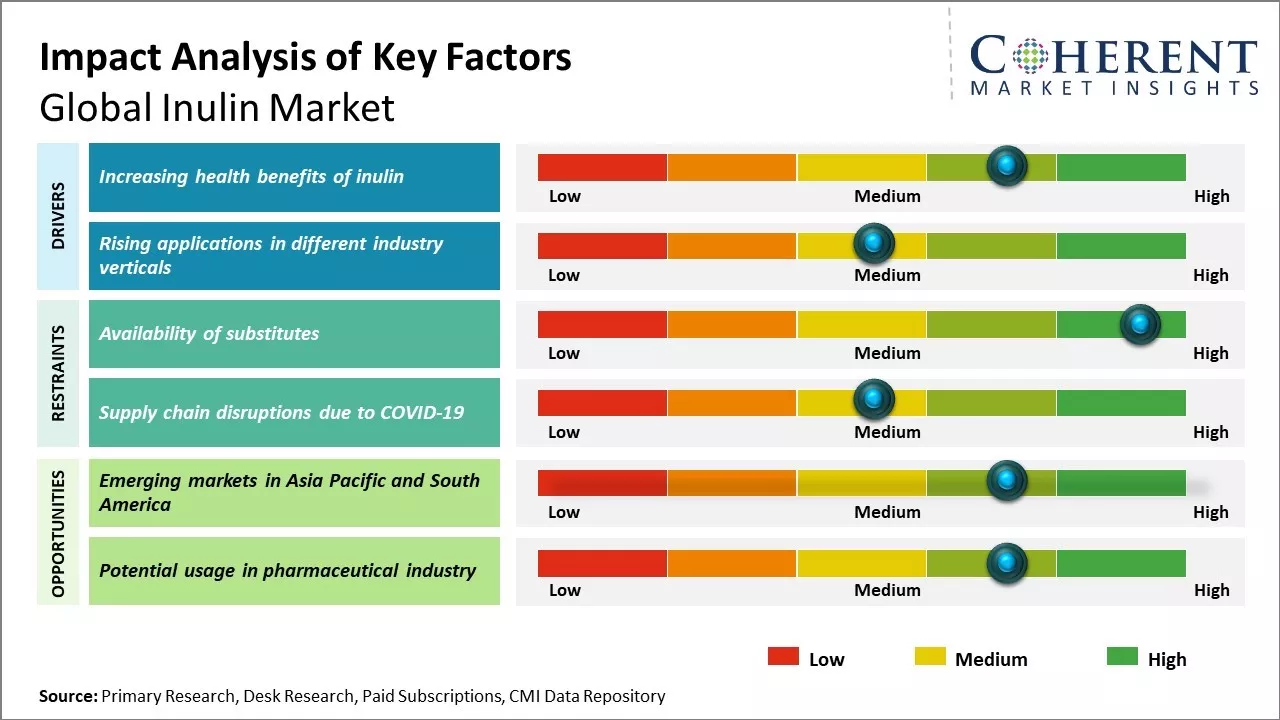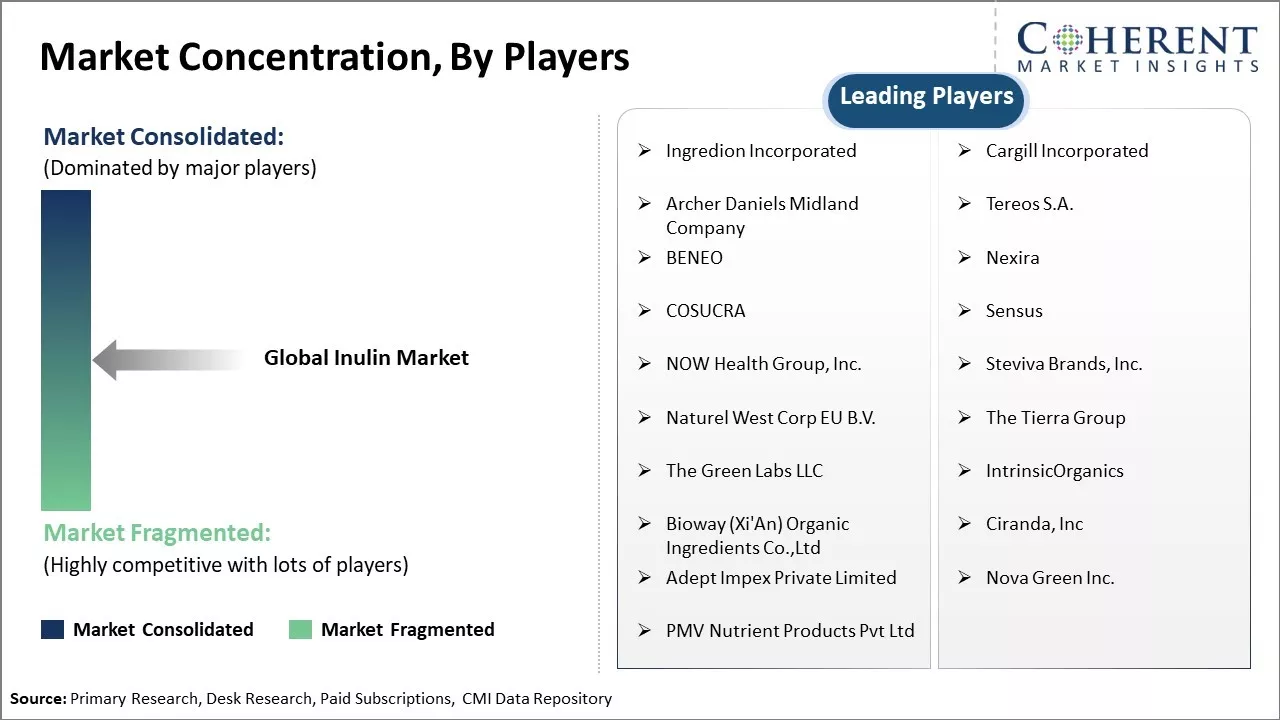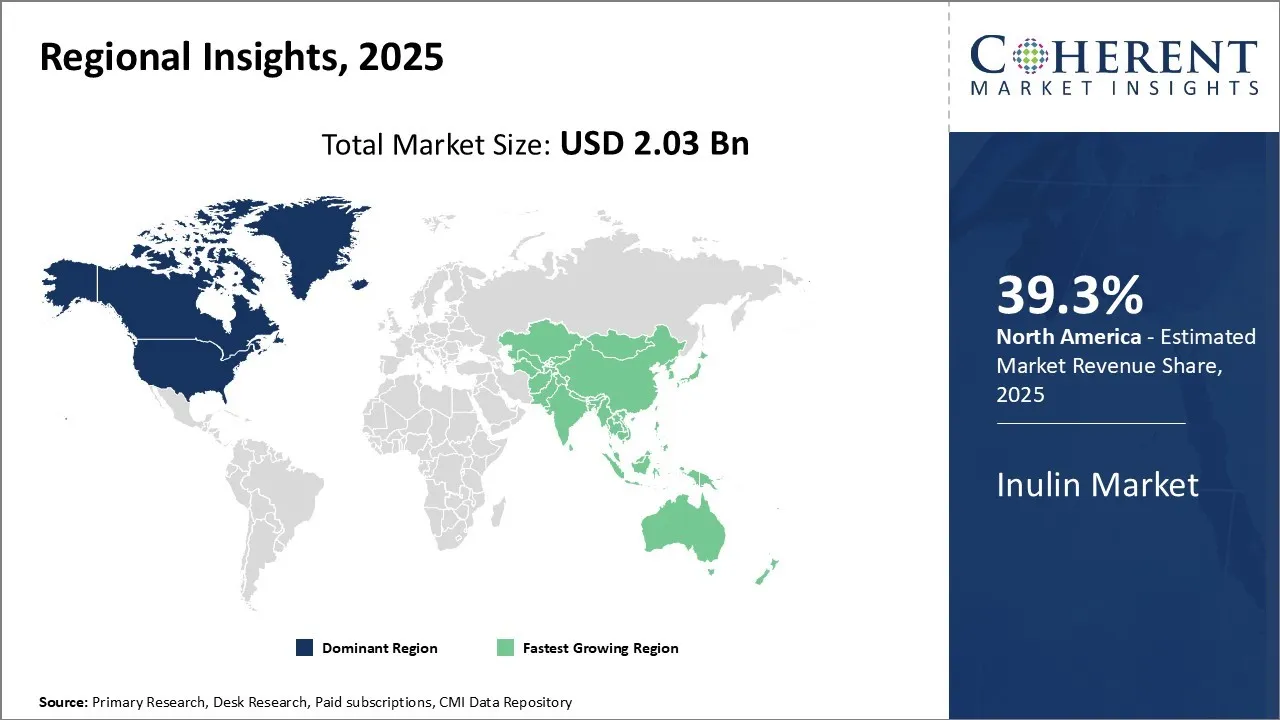The inulin market is estimated to be valued at USD 2.03 Bn in 2025 and is expected to reach USD 3.14 Bn by 2032, exhibiting a compound annual growth rate (CAGR) of 6.4% from 2025 to 2032.

To learn more about this report, Download Free Sample
Inulin is predominantly used as a dietary fiber in various food and beverage products aiming to provide associated health benefits to consumers. The inulin market is anticipated to witness significant growth over the forecast period. The increasing demand for prebiotics and low-calorie sugar alternatives in the food and beverage industry is expected to boost the market growth. Additionally, the rising awareness about the health benefits of inulin among consumers is further expected to drive the demand.
However, the availability of substitutes, such as polydextrose and other soluble fibers, can hamper the growth of the inulin market.

To learn more about this report, Download Free Sample
|
Current Events |
Description and its impact |
|
Geopolitical and Trade Developments |
|
|
Technological and Production Innovations |
|
Uncover macros and micros vetted on 75+ parameters: Get instant access to report
Inulin witnesses robust growth opportunities beyond just the food industry. Its functional properties related to texture, mouthfeel, and calorie reduction have augmented its use in various other sectors. For instance, inulin finds widespread applications in cosmetics and personal care products due to its moisturizing and soothing properties. It is used in formulations of lotions, creams, and face masks. The booming cosmetics industry worldwide has increased the consumption of inulin.
The availability of substitutes is posing a serious threat to the growth of the inulin market. There are several substitutes available for inulin that perform similar functionalities in food and beverages. One of the major substitutes is oligofructose, which like inulin, is a fructan obtained from chicory and Jerusalem artichoke. It is cheaper than inulin and widely available globally. This has prompted many manufacturers to switch to oligofructose from inulin.
In terms of nature, organic is expected to contribute 69.2% share of the market in 2025. This is primarily attributed to the rising demand for organic and natural products among health-conscious consumers. People are increasingly realizing the importance of consuming chemical-free food products for overall well-being.
There is great awareness about the adverse effects of synthetic pesticides and fertilizers used in conventional farming practices. The clean label trend is also pushing the sales of organic inulin upwards. Manufacturers are able to command a premium for organic inulin due to its inherent benefits. It is grown without the use of synthetic additives and approved for use in organic food products certified by regulatory organizations. This offers advantage to food processors targeting health-oriented buyers.
The food and beverage segment dominates the overall inulin market in terms of applications. This segment is expected to account for 36% of the market share in 2025. Inulin finds wide utilization in various food products due to its desirable functional properties and health benefits.
Being a versatile ingredient, inulin is used as a fiber enhancer in many foods such as bakery, dairy, meat, and cereal products. It helps manufacturers develop high-fiber offerings. As consumer preference undergoes a major shift toward fiber-rich diets, inulin emerges as a popular solution. Furthermore, inulin acts as a fat replacer in low-calorie products. It adds volume and mouthfeel without additional calories.
Artificial Intelligence (AI) is revolutionizing numerous sectors, and the inulin market is no exception. Inulin, a naturally occurring prebiotic fiber extracted primarily from chicory roots, has gained increasing demand for its health benefits in food, pharmaceuticals, and nutraceuticals.

To learn more about this report, Download Free Sample
North America is the dominant region and is expected to account for 39.3% share in 2025. The presence of leading inulin manufacturers such as Beneo GmbH and Cargill Inc has strengthened the supply network in this region. These players have established robust distribution channels to cater to the growing demand from food & beverage industry.
For instance, in December 2024, ICL, a leading global specialty minerals company, announced a follow-on investment in Plantible Foods, participating in the company’s Series B funding round. This investment builds upon ICL’s initial participation in Plantible’s Series A round and furthers the strategic collaboration between the two companies.
The presence of nearly 60.5% of the world's population provides immense opportunities for the expansion of inulin market in Asia Pacific. Changing demographics, improving living standards, and rising expendable income in Asia Pacific's developing economies such as India and China have boosted the demand for high-value functional ingredients in this region.
For instance, in May 2025, Arla Foods Ingredients has extended its distribution partnership with the Brenntag Group to include Southeast Asia’s three largest food and nutrition markets. The expanded collaboration will see Brenntag distributing Arla Foods Ingredients’ extensive portfolio of protein ingredients in Vietnam, Thailand and Indonesia. It will cover a wide range of categories, including health foods, infant nutrition and sports nutrition, as well as solutions for functionality in dairy and bakery. expanding distribution networks and premium ingredient uptake in Asia Pacific. It provides a real-world anchor to the broader thesis about the inulin opportunity in the region.
In the U.S., the growing focus on dietary fiber labeling and health claims regulation by the Food and Drug Administration (FDA) is significantly impacting the inulin market. This regulatory clarity has encouraged food manufacturers to incorporate inulin as a prebiotic fiber to meet consumer demand for gut health and low-sugar formulations. However, compliance with strict labeling and health claim standards requires additional investment in testing and product validation.
According to Weill Cornell Medicine in May 2024, a study published in the Journal of Experimental Medicine found that inulin—which is naturally present in foods like garlic, leeks, and sunchoke, and commonly used in fiber supplements—prompts gut microbes to release bile acids that trigger the production of inflammatory molecules in the intestine.
Health Canada’s regulatory framework for novel foods and its emphasis on natural health products (NHPs) have contributed to a rising demand for inulin as a functional ingredient. As Canadians become more health-conscious and interested in digestive wellness, regulatory support for clean-label ingredients has created a favorable market environment.
India’s Food Safety and Standards Authority of India (FSSAI) is increasingly promoting the use of dietary fibers in processed foods to address growing public health issues like constipation, diabetes, and obesity. This push, combined with a surge in consumer awareness around gut health, has expanded opportunities for inulin in sectors like bakery, dairy, and nutraceuticals.
In China, regulatory efforts to combat rising rates of diabetes and obesity are encouraging the use of low-glycemic and high-fiber ingredients, such as inulin, in food and beverage products. The National Health Commission (NHC) has approved inulin for use in various applications, and the government is actively promoting the development of the domestic functional food industry.
| Report Coverage | Details | ||
|---|---|---|---|
| Base Year: | 2024 | Market Size in 2025: | USD 2.03 Bn |
| Historical Data for: | 2020 To 2024 | Forecast Period: | 2025 To 2032 |
| Forecast Period 2025 to 2032 CAGR: | 6.4% | 2032 Value Projection: | USD 3.14 Bn |
| Geographies covered: |
|
||
| Segments covered: |
|
||
| Companies covered: |
Ingredion Incorporated, Cargill Incorporated, Archer Daniels Midland Company, Tereos S.A., BENEO, Nexira, COSUCRA, Sensus, NOW Health Group, Inc., Steviva Brands, Inc., Naturel West Corp EU B.V., The Tierra Group, The Green Labs LLC, IntrinsicOrganics, Bioway (Xi'An) Organic Ingredients Co.,Ltd, Ciranda, Inc, Adept Impex Private Limited, Nova Green Inc., and PMV Nutrient Products Pvt Ltd |
||
| Growth Drivers: |
|
||
| Restraints & Challenges: |
|
||
Uncover macros and micros vetted on 75+ parameters: Get instant access to report
*Definition: The inulin market focuses on the sale of inulin, a type of soluble dietary fiber found in many plant foods. Inulin is extracted from chicory roots and other plants to be used as a fiber supplement or low-calorie sweetener. The inulin market caters to industries involved in food and beverage manufacturing, dietary supplements, personal care products, and others. Buyers look to purchase various inulin ingredients to add nutritional benefits and improve texture in their products for health-conscious consumers.
Share
Share
About Author
Sakshi Suryawanshi is a Research Consultant with 6 years of extensive experience in market research and consulting. She is proficient in market estimation, competitive analysis, and patent analysis. Sakshi excels in identifying market trends and evaluating competitive landscapes to provide actionable insights that drive strategic decision-making. Her expertise helps businesses navigate complex market dynamics and achieve their objectives effectively.
Missing comfort of reading report in your local language? Find your preferred language :
Transform your Strategy with Exclusive Trending Reports :
Frequently Asked Questions
Joining thousands of companies around the world committed to making the Excellent Business Solutions.
View All Our Clients